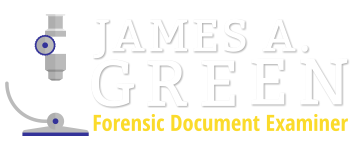Signature forgeries are the most common type of issue clients present to the signature expert they hire. Many of the involved signatures are abbreviated and lack a few or many of the individual letters in the name. It is common for people signing their name frequently to simplify their signature. However, reducing the complexity of a signature increases the ability for someone to simulate it. A complex, fluently written signature minimizes the opportunity for a successful ‘forgery’ of the name.
Many abbreviated signatures examined by this document expert were limited to one or two letters. For a person signing their name several times throughout the day, shortening their signature to essentially their initials may serve as a time saver. However, removing the complex structure of a full signature equates to a lessor effort necessary to successfully simulate it.
Recall examples of beautifully scripted writing of people in days gone past, when such writing was a matter of pride as well as a major requirement in the school system. Now think of how you would reproduce that type of signature in a fluently written manner while incorporating all of the detail in proper proportions. A signature forgery of a well executed cursive signature would be a daunting challenge.
The most common process used for signature forgeries is a free-hand simulation. The writer simply uses a true signature of the person as a model, placed near the signature line where the forger will copy the genuine signature as well as they can. If the forger lacks the motor skill ability to make a passable forgery, he/she may opt for a “cut and paste” fabrication. That type of signature forgery is simply the transfer of a genuine signature from one document to another using a software program such as PhotoShop or Paint.

